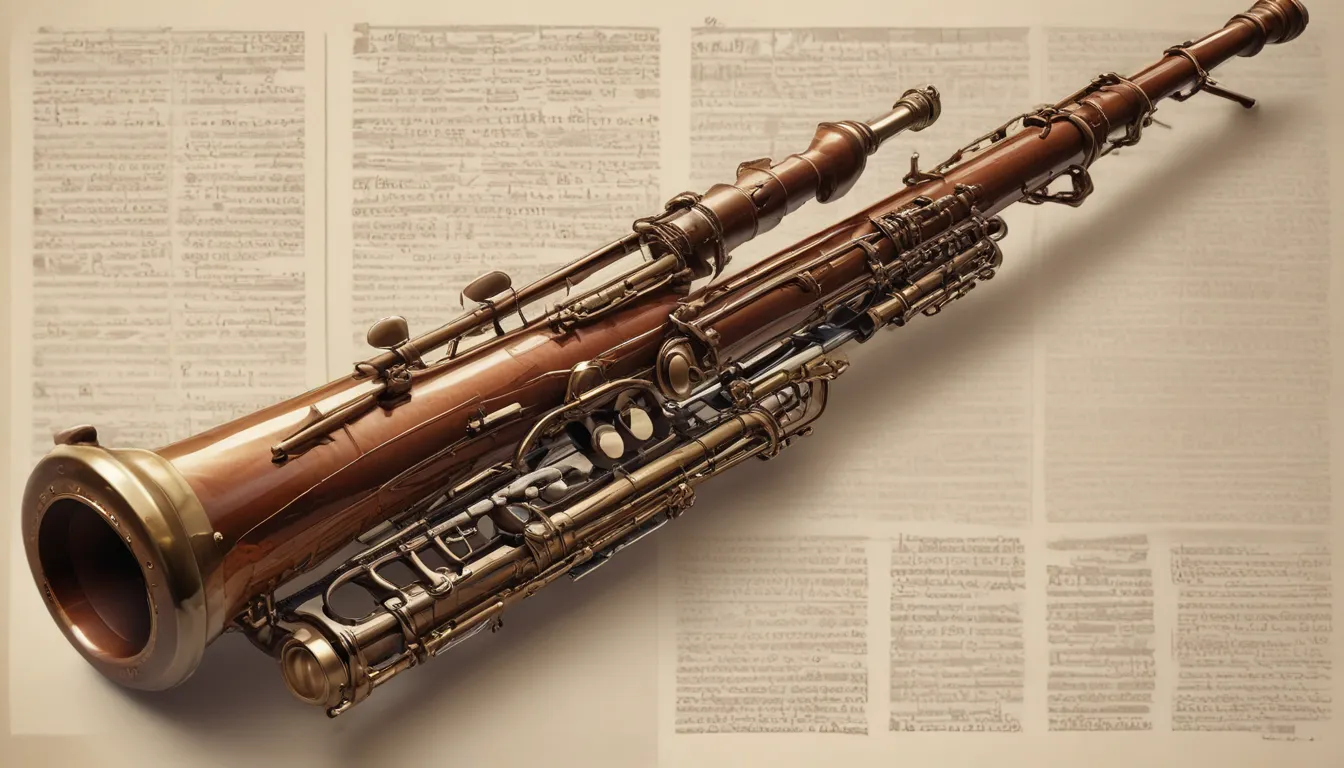The images in our articles may not match the content exactly. They are used to grab your attention, not to show the exact details in the text. The images complement the text but do not replace it.
If you’ve ever been captivated by the rich and distinctive sound of the bassoon in classical music, you’re not alone. This double-reed instrument, with its deep timbre and whimsical appearance, has carved out a unique place in the world of music. In this article, we’ll explore 19 fascinating facts about the bassoon, from its historical roots to its versatile repertoire and cultural significance. Join us on a musical journey as we unravel the enchantment of this extraordinary instrument.
Unraveling Historical Roots
The bassoon’s journey dates back to the 16th century, where it emerged in Europe as an evolution of earlier double-reed instruments like the shawm and dulcian. These early forms paved the way for the development of the bassoon as we know it today.
Delving into the Double Reed Wonder
One defining feature of the bassoon is its use of a double reed, crafted from Arundo donax cane, bound together to produce its distinctive sound. This unique design sets the bassoon apart from other woodwind instruments, adding to its allure and complexity.
Embracing the Basso Profundo Sound
Known as the “basso profundo” of the orchestra, the bassoon boasts a deep and resonant sound that contributes depth and character to orchestral compositions. Its wide range allows it to play both melodic lines and provide essential bass support, making it a versatile instrument in various musical settings.
Understanding the Complex Design
The bassoon’s intricate design features long tubes, keys, and finger holes, culminating in its approximately 4.5 to 5 feet length when fully assembled. It stands as one of the largest and longest woodwind instruments, showcasing the craftsmanship and attention to detail required for its construction.
Exploring its Woodwind Family Roots
As a member of the woodwind family, the bassoon shares its lineage with instruments like the flute, clarinet, and oboe. However, its double-reed design and sophisticated key system set it apart, making it a unique and essential component of the woodwind section in orchestras and ensembles.
Tenor or Bass? The Bassoon’s Range
Despite being often categorized as a “bass” instrument, the bassoon technically belongs to the tenor register. Its range spans from B♭1 to E5, offering vital harmonic support and versatility across various musical genres, from classical to jazz and beyond.
Unlocking the Keyed Instrument’s Secrets
With up to 25 keys and 9 to 12 finger holes, the bassoon’s elaborate key system gives players precise control over pitch and notes. Manipulating these keys and holes with finesse and skill is essential for producing the nuanced and expressive sounds that define the instrument.
Reaching New Musical Depths
The lowest note commonly played on the bassoon is the B♭1, showcasing its impressive range among woodwind instruments. Advanced players can even venture into the subcontra B♭ range, pushing the boundaries of the instrument’s capabilities to create deep, resonant tones.
Embracing the Whimsical Appearance
The bassoon’s distinctive “S” bend, long, curved shape, and numerous keys give it a whimsical and memorable appearance. Its visual charm is as captivating as its musical prowess, making it a beloved and recognizable instrument in the world of music.
Diving into Versatile Repertoire
From solo works and concertos to ensemble and orchestral compositions, the bassoon boasts a diverse and versatile repertoire. While it shines in classical music, it has also made a mark in genres like jazz and popular music, showcasing its adaptability and enduring appeal.
Recognizing Soloistic Opportunities
While often playing a supporting role in orchestras, the bassoon occasionally steps into the spotlight as a solo instrument. Renowned composers like Mozart, Weber, and Vivaldi have crafted exquisite concertos and chamber music pieces that feature the bassoon’s expressive and melodic qualities.
Navigating Reed Dilemmas
The bassoon’s double-reed nature necessitates careful reed maintenance and adjustment. Players devote significant time and effort to crafting and fine-tuning their reeds to achieve the desired tone and responsiveness, highlighting the importance of this often-overlooked aspect of bassoon playing.
Anchoring the Orchestra
In orchestral settings, the bassoon serves as a foundational element, providing stability and depth to the overall sound. Its contributions in the bass and middle registers enrich the ensemble’s sonic palette, imbuing performances with richness and gravitas.
Exploring Bassoon Quartets
The rising popularity of bassoon quartets, featuring four bassoons, showcases the instrument’s versatility and range in a chamber music setting. These ensembles offer a unique opportunity for bassoonists to explore collaborative performance and highlight the instrument’s capabilities in a new light.
Celebrating Influential Bassoonists
Throughout history, influential bassoonists like François René Gebauer, Gustavo Núñez, and Klaus Thunemann have left a lasting impact on the artistry and technique of bassoon playing. Their contributions have helped shape the evolution of the instrument and inspire generations of musicians.
Harmonizing in Bassoon Ensembles
Bassoon ensembles, featuring multiple bassoons and other woodwind instruments, create a rich and resonant ensemble sound. These collaborative settings allow players to delve into unique arrangements and explore the full potential of the instrument in a group setting.
Understanding Cultural Significance
The bassoon holds cultural significance in various countries and traditions, with each region infusing its own narratives and themes into the instrument’s identity. For instance, in Germany, the bassoon’s association with forest and hunting themes is a prominent theme in folk music and storytelling, reflecting its deep-rooted cultural ties.
Tracing Renaissance and Baroque Beginnings
The bassoon’s early predecessors, rooted in the Renaissance and Baroque periods, laid the foundation for its eventual development and refinement. Over time, improvements in design and key mechanisms have shaped the bassoon into the versatile and expressive instrument we know today.
Embracing a World of Bassoons
Bassoons come in various sizes and styles to cater to different players and musical needs. From the standard bassoon to the larger contrabassoon and the smaller tenoroon, each variant brings its unique voice to the woodwind section, enriching the musical landscape with its distinct timbre and capabilities.
Conclusion: A Melodious Journey Comes to an End
The enchanting world of the bassoon beckons, inviting players and enthusiasts alike to immerse themselves in its captivating allure. From its historical origins and intricate design to its cultural significance and versatile repertoire, the bassoon continues to enchant audiences with its deep and melodious voice. Whether nestled in a symphony’s harmonious melodies or front and center in a virtuosic solo performance, the bassoon stands as a testament to the enduring power and beauty of music.
Frequently Asked Questions (FAQs)
How heavy is a bassoon?
A bassoon typically weighs around 7 to 9 pounds (3.2 to 4.1 kilograms), depending on the specific model and materials used in its construction.
What is the highest note a bassoon can play?
The highest note commonly played on the bassoon is the E5. Advanced players can sometimes reach even higher notes with proper technique and adjustments to the instrument.
How long does it take to learn to play the bassoon?
Learning to play the bassoon requires time and dedication. It can take several years of practice to become proficient in playing the instrument, with the length of time varying depending on the individual’s commitment and previous musical experience.
Can children learn to play the bassoon?
While the bassoon is generally a larger instrument and may require some physical strength to handle, children can learn to play the bassoon. Smaller-sized bassoons, such as the tenoroon or mini bassoon, are designed to accommodate younger players.
Are bassoons expensive?
Bassoons can be quite expensive due to their intricate design and craftsmanship. Prices for new bassoons range from several thousand dollars to tens of thousands of dollars, depending on the quality and brand of the instrument.
Embrace the enchantment of the bassoon as you delve into its rich history, intricate design, and cultural significance. Whether you’re a seasoned player or a curious listener, the world of the bassoon offers a wealth of fascination and discovery. Join us on this musical journey as we celebrate the captivating allure of this remarkable instrument.






